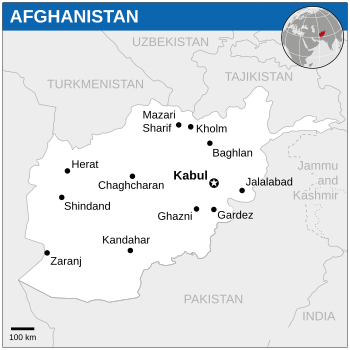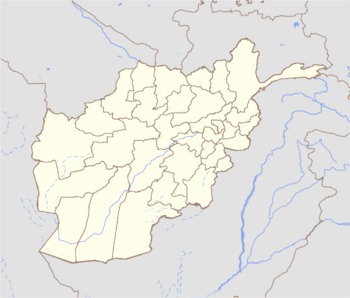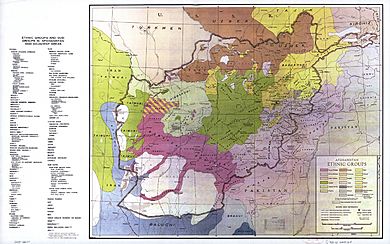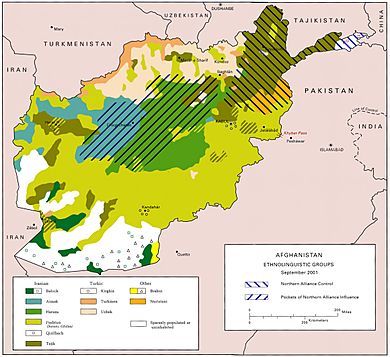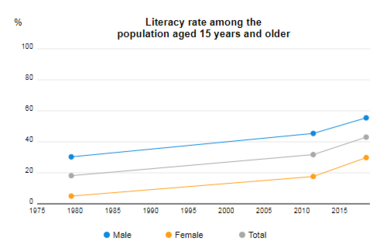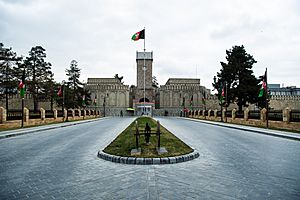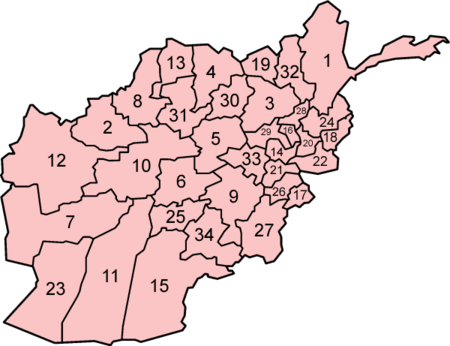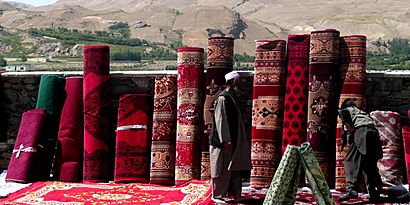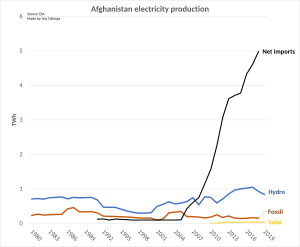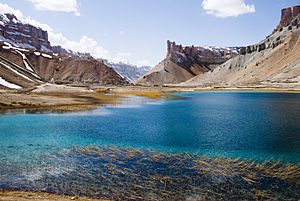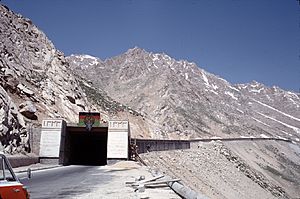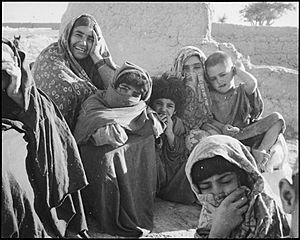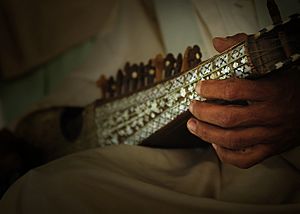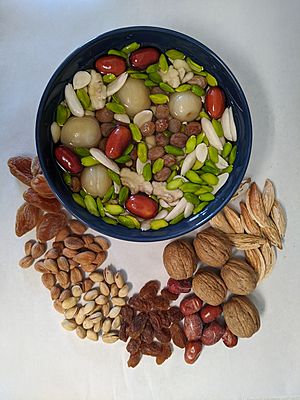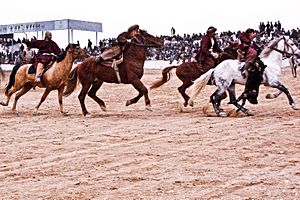Afghanistan facts for kids
Quick facts for kids
Islamic Emirate of Afghanistan
|
|
|---|---|
|
Anthem: دا د باتورانو کور
"Dā Də Bātorāno Kor" "This Is the Home of the Brave" |
|
| Status | UN member state under an unrecognized government |
| Capital and largest city
|
Kabul 34°31′N 69°11′E / 34.517°N 69.183°E |
| Official languages | |
| Ethnic groups
(2019 unofficial estimates)
|
|
| Religion
(2015)
|
|
| Demonym(s) | Afghan |
| Government | Unitary totalitarian provisional theocratic Islamic emirate |
|
• Supreme Leader
|
Hibatullah Akhundzada |
| Hasan Akhund (acting) | |
| Abdul Hakim Haqqani | |
| Legislature | None |
| Formation | |
| 1709–1738 | |
| 1747–1823 | |
|
• Emirate
|
1823–1839 |
| 1839–1842 | |
|
• Restoration of the Emirate
|
1842–1926 |
| 27 May 1863 | |
| 26 May 1879 | |
| 19 August 1919 | |
|
• Kingdom
|
9 June 1926 |
|
• Republic
|
17 July 1973 |
|
• Democratic Republic
|
27–28 April 1978 |
| 28 April 1992 | |
|
• Islamic Emirate
|
27 September 1996 |
|
• Islamic Republic
|
26 January 2004 |
| 15 August 2021 | |
| Area | |
|
• Total
|
652,867 km2 (252,073 sq mi) (40th) |
|
• Water (%)
|
negligible |
| Population | |
|
• 2023 estimate
|
|
|
• Density
|
48.08/km2 (124.5/sq mi) |
| GDP (PPP) | 2020 estimate |
|
• Total
|
$81.007 billion |
|
• Per capita
|
$2,459 |
| GDP (nominal) | 2020 estimate |
|
• Total
|
$20.136 billion |
|
• Per capita
|
$611 |
| HDI (2022) | low · 182nd |
| Currency | Afghani (افغانى) (AFN) |
| Time zone | UTC+4:30 Lunar Calendar (Afghanistan Time) |
| DST is not observed | |
| ISO 3166 code | AF |
| Internet TLD | .af |
Afghanistan, officially known as the Islamic Emirate of Afghanistan, is a country that doesn't have a coastline. It's located where Central Asia and South Asia meet. People sometimes call it the "Heart of Asia." It shares borders with Pakistan, Iran, Turkmenistan, Uzbekistan, Tajikistan, and China.
Afghanistan covers about 652,864 square kilometers (252,072 square miles). Most of the country is mountainous, especially with the Hindu Kush mountain range. There are also flatter areas in the north and southwest. Kabul is the biggest city and the capital. In 2021, Afghanistan's population was around 40.2 million people. It's made up of many different ethnic groups, like Pashtuns, Tajiks, Hazaras, and Uzbeks.
People have lived in Afghanistan since the Stone Age. Its location on the historic Silk Road made it a busy place for trade and travel. Many empires and armies have passed through Afghanistan, including those led by Alexander the Great, the Mongols, the British, and the Soviet Union. This is why it's sometimes called the "graveyard of empires." The area has been a center for different religions like Zoroastrianism, Buddhism, Hinduism, and later, Islam.
The modern country of Afghanistan began in the 18th century with the Durrani dynasty. Later, Dost Mohammad Khan helped unite the different parts of Afghanistan in the 19th century. For a long time, Afghanistan was a "buffer state" between the British Empire and the Russian Empire. After several wars, Afghanistan gained full independence in 1919 and became a kingdom.
Since the late 1970s, Afghanistan has faced a lot of conflict. This includes civil wars and invasions. In 1979, the Soviet Union invaded. After they left, different groups fought for control. The Taliban, an Islamic group, took over most of the country by 1996. However, their government was not widely recognized by other countries. In 2001, a US-led group invaded and removed the Taliban from power. But in 2021, the Taliban returned and took control of Kabul, ending the 20-year war. They re-established the Islamic Emirate of Afghanistan, but this government is not yet recognized by most countries.
Afghanistan has many natural resources like lithium, iron, zinc, and copper. It's also a top producer of saffron and cashmere. The country is a member of groups like the South Asian Association for Regional Cooperation and the Organization of Islamic Cooperation. Because of years of war, Afghanistan has faced challenges like terrorism, poverty, and child malnutrition. It is still one of the least developed countries in the world.
Contents
What's in a Name?
The name Afghan might come from the old Sanskrit word Aśvakan, meaning "horsemen." This name was used for people living in the Hindu Kush mountains long ago. Other ideas suggest it comes from the Bactrian language.
Historically, "Afghan" referred mainly to the Pashtuns. The word Afġān first appeared in a geography book in the 10th century. The second part of the name, "-stan", is a Persian word meaning "place of." So, "Afghanistan" means "land of the Afghans" or "land of the Pashtuns." The name "Afghanistan" was officially used in 1855. This was when the British recognized Dost Mohammad Khan as the ruler.
Exploring Afghanistan's Geography
Where is Afghanistan Located?
Afghanistan is in Southern-Central Asia. It's often called the "crossroads of Asia" or the "Heart of Asia." A famous poet once wrote that Afghanistan is like the heart of Asia. If Afghanistan is in trouble, Asia is in trouble. If Afghanistan is peaceful, Asia is peaceful.
Afghanistan is about 652,864 square kilometers (252,072 square miles). This makes it the 41st largest country in the world. It's a bit bigger than France. Since it's landlocked, it has no coastline. Its longest border is with Pakistan. It also borders Tajikistan, Iran, Turkmenistan, Uzbekistan, and China.
Mountains, Plains, and Rivers

Afghanistan's land is mostly mountainous and rugged. The Hindu Kush mountain range runs through it. This range is part of the Himalayas. Most of the highest points are in the east. These areas have fertile mountain valleys. The Hindu Kush ends in the west-central highlands. This creates plains in the north and southwest. These plains have grasslands, semi-deserts, and hot, windy deserts. Forests are found in some eastern provinces. The highest point is Noshaq, which is 7,492 meters (24,580 feet) above sea level.
Even with many rivers and lakes, large parts of Afghanistan are dry. The Amu Darya river starts north of the Hindu Kush. Other rivers like the Hari Rud and Helmand River flow through the country. The Kabul River flows east towards the Indus River. In winter, the mountains get heavy snow. This melting snow fills the rivers and lakes in spring. However, two-thirds of Afghanistan's water flows into neighboring countries.
Earthquakes and Climate
The northeastern Hindu Kush mountains are an active area for earthquakes. Earthquakes can happen almost every year. They can be very strong and cause landslides or avalanches in winter. For example, a strong earthquake in 1998 killed about 6,000 people.
Afghanistan has a continental climate. This means it has cold winters and hot summers. In the high mountains, January temperatures can drop below -15°C (5°F). In the low-lying areas, July temperatures can go above 35°C (95°F). Most rain falls between December and April. The northern and western parts are the driest.
Wildlife and Nature
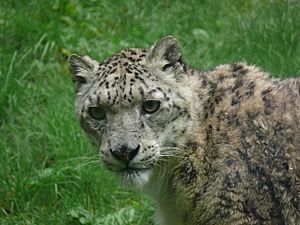
Many different animals live in Afghanistan. Snow leopards and brown bears live in the high mountains. The Marco Polo sheep is found only in the Wakhan Corridor. Foxes, wolves, and deer live in the mountain forests. In the northern plains, you can find birds, hedgehogs, and large meat-eaters like jackals.
Gazelles and wild pigs live in the southern and western plains. The Afghan Hound is a special dog breed from Afghanistan. It's known for being fast and having long hair. Afghanistan also has unique animals like the Afghan flying squirrel and the Afghan snowfinch.
The forests have pine, spruce, and fir trees. Grasslands have short grass and shrubs. Colder, high-up regions have tough grasses and small flowering plants. Afghanistan has three national parks: Band-e Amir, Wakhan, and Nuristan.
People of Afghanistan
Population and Ethnic Groups
In 2019, Afghanistan's population was estimated at 32.9 million. Most people live in rural areas. About 3 million Afghans also live temporarily in Pakistan and Iran. Afghanistan has one of the fastest growing populations outside of Africa. This is partly because many refugees have returned.
Afghans belong to many different ethnic groups. The Pashtuns are the largest group, making up 42% of the population. The Tajiks are the second largest at 27%. Other major groups include the Hazaras and Uzbeks, each at 9%. Ten other ethnic groups are also recognized in the Afghan National Anthem.
Languages Spoken in Afghanistan
Dari and Pashto are the official languages. Many Afghans speak both. Dari is similar to Persian and is often used as a common language in Kabul and the northern parts of the country. Pashto is the main language of the Pashtuns. Many Pashtuns also speak Dari.
Other languages spoken include Uzbek, Turkmen, and Balochi. Many Afghans can also understand Hindustani (Urdu-Hindi). This is because of returning refugees from Pakistan and the popularity of Bollywood movies. English is also becoming more common.
Religion in Afghanistan
Most Afghans are Muslim, about 99.7% of the population. Most of them follow the Sunni branch of Islam. There are also smaller groups of Shia Muslims.
Small communities of Sikhs and Hindus live in major cities like Kabul. They have their own places of worship. There used to be a small Jewish community, but most have left due to conflict. Christians in Afghanistan practice their faith in private.
Cities and Education
About 26% of Afghans live in cities. This is a low number compared to other countries. Urban areas have grown quickly, especially Kabul. This is due to people moving back from other countries and from rural areas.
Kabul is the only city with over a million people. Other large cities include Kandahar in the south, Herat in the west, and Mazar-i-Sharif in the north.
Education in Afghanistan is managed by the Ministry of Education. There are over 16,000 schools and about 9 million students. About 40% of these students are girls. However, the current government has limited girls' access to secondary schools. There are also many universities across the country. The top universities are the American University of Afghanistan and Kabul University.
How Afghanistan is Governed
After the previous government fell in 2021, the Taliban declared Afghanistan an Islamic Emirate. A new temporary government was announced. As of now, most other countries have not officially recognized this government.
A traditional way of making decisions in Afghanistan is through a loya jirga. This is a large meeting of leaders and elders. It's used to choose new leaders or solve big national problems. Loya jirgas have been held for centuries.
The Current Government
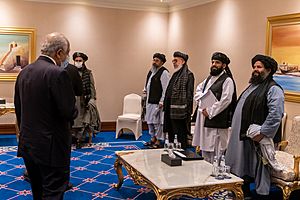
The Taliban leader, Hibatullah Akhundzada, is the Supreme Leader. Other important leaders include Hasan Akhund as the acting Prime Minister. The government is made up entirely of Taliban members.
The government has faced protests, especially from women. They have called for women to be included in the government. However, the acting government announced in September 2021 was made up only of men. The Ministry of Women's Affairs also seemed to be removed. In May 2022, the Human Rights Commission was dissolved.
Provinces and Districts
Afghanistan is divided into 34 provinces. Each province has a governor and a capital city. These provinces are then divided into almost 400 districts. Each district has its own governor.
The provincial governors are chosen by the Prime Minister. They represent the central government in their provinces. There are also provincial councils. These councils help with development planning and check on other government groups in the province.
Here are the 34 provinces:
International Relations
Afghanistan joined the United Nations in 1946. In the past, it had good relationships with countries like Germany, the Soviet Union, and India. Relations with Pakistan have often been difficult.
The current government of Afghanistan is not recognized by most countries. However, it has unofficial ties with China, Pakistan, and Qatar. Before 2021, Afghanistan had good relations with many NATO countries, including the United States and the United Kingdom.
Afghanistan's Economy
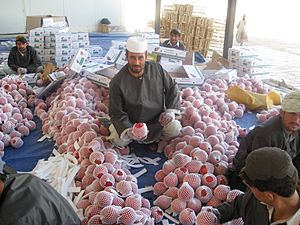
Afghanistan's economy is still developing. It has a lot of mineral resources, possibly worth over $1 trillion. But it remains one of the world's least developed countries. This is due to its mountains, being landlocked, and ongoing conflict. The country imports more goods than it exports. Its main exports are fruits and nuts.
The Afghani (AFN) is the national money. The central bank is called Da Afghanistan Bank. Many local and foreign banks operate in the country.
Many Afghans who lived abroad have returned. They have helped the economy by starting businesses. Construction is a big industry. Major projects include new cities and towns. The telecom industry has also grown a lot, creating many jobs. Afghan rugs are also a popular export.
Afghanistan is a member of the WTO and other international groups. Most of its imports come from Iran, China, Pakistan, and Kazakhstan. Most exports go to Pakistan and India. Since the Taliban took over in 2021, the United States has frozen about $9 billion of Afghanistan's central bank assets. This has made it harder for the Taliban to access money.
Farming and Mining
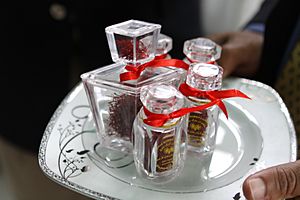
Farming is very important to Afghanistan's economy. About 40% of people work in agriculture. The country is known for growing pomegranates, grapes, apricots, and melons.
Saffron, a very expensive spice, grows well in Afghanistan. Farmers are trying to grow more saffron instead of other crops. Afghan saffron has been ranked the best in the world.
Afghanistan has many natural resources. These include coal, copper, iron ore, lithium, uranium, and precious stones. Experts believe these minerals are worth a lot of money. For example, the Aynak copper mine is a huge project. It's the biggest foreign investment in Afghanistan's history. Some say Afghanistan could become like the "Saudi Arabia of lithium."
Infrastructure and Travel
Energy and Power
Most people in Afghanistan have access to electricity. The country produces some of its own power, mainly from hydropower (using water). But it still buys most of its electricity from neighboring countries. There are also more solar and wind power plants being built. Important dams include the Kajaki Dam.
Tourism and Attractions
Tourism is a small industry in Afghanistan because of safety concerns. However, some foreign tourists visit each year. The Bamyan Valley is a beautiful area with lakes, canyons, and historical sites. It's a safe place to visit. The Wakhan Valley is also popular for trekking.
In the 1960s, Afghanistan was a popular stop on the "hippie trail." Many Europeans and Americans traveled through cities like Herat, Kandahar, and Kabul. Tourism was highest in 1977, just before the country's conflicts began.

The city of Ghazni has a rich history and many historical sites. The Minaret of Jam is a UNESCO World Heritage Site. The Shrine of the Cloak in Kandahar is believed to hold a cloak worn by the prophet Muhammad. The citadel of Alexander in Herat has been restored. In the north, the Shrine of Ali is believed to be where Ali was buried. The National Museum of Afghanistan in Kabul has many ancient artifacts.
Communication and Transportation
Afghanistan has many radio and television stations. The state broadcaster is Radio Television Afghanistan. There are also many private TV channels. The first Afghan newspaper was published in 1873. Afghanistan uses its own space satellite for phones, internet, and TV. The number of mobile phone users and internet users has grown a lot since 2001.
Traveling in Afghanistan can be difficult because of its mountains. The main road network is called "Highway 1" or the "Ring Road." It connects major cities like Kabul, Kandahar, and Herat. The Salang Tunnel is a key part of this road. It helps people travel through the Hindu Kush mountains.
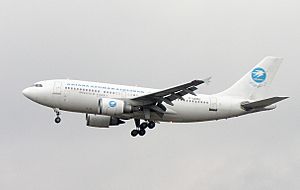
Air travel is available through Ariana Afghan Airlines and Kam Air. Several international airlines also fly to Afghanistan. The country has four international airports.
Afghanistan has a few rail links, mainly for cargo. There are plans to build more railway lines. Many people own private cars now. Taxis are yellow. In rural areas, people use donkeys, mules, or horses for transport. Camels are used by nomadic people. Bicycles are also popular.
Afghan Culture
Afghan culture has common features but also differences between regions. This is because of the mountains that divide the country. Family is very important in Afghan society. In the south and east, people follow the Pashtun culture and its code, Pashtunwali. This includes being very welcoming and offering safety to those who need it. Afghans are known for their strong religious beliefs.
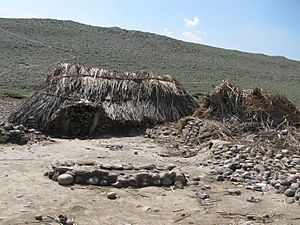
In villages, families often live in houses made of mudbrick. Villages usually have a headman, a water manager, and a religious teacher. Men work in the fields, and women help during harvest. About 15% of the population are nomadic, called kochis.
Clothing and Art
Afghan clothing for men and women often includes the shalwar kameez. Women usually wear a chador to cover their heads. Some women wear a burqa, which covers the whole body. The karakul is a hat made from sheep fur. It was worn by former kings and became famous when President Hamid Karzai wore it.
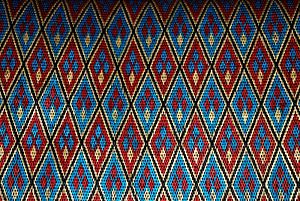
Carpet weaving is an old tradition in Afghanistan. Many carpets are still handmade by tribal people. Crafters often show their feelings through the designs. Each province has its own style of making rugs.
Pottery has been made in Afghanistan for thousands of years. The village of Istalif is known for its unique turquoise and green pottery. Afghanistan is also where many lapis lazuli stones come from. These blue stones were used in ancient art.
Afghanistan has a long history of art. The world's first known oil paintings were found in caves there. Gandhara Art is a famous style that mixed Greek and Buddhist art. Later, Persian miniature painting became popular.
Media and Entertainment
Afghans enjoy watching Indian Bollywood films and listening to their songs. Many Bollywood stars have roots in Afghanistan. Some Bollywood movies have even been filmed in Afghanistan.
Music and Dance
Afghan classical music is linked to Indian classical music. It uses similar instruments like the tabla and sitar. The rubab is Afghanistan's national instrument. Famous classical artists include Ustad Sarahang.
Pop music became popular in the 1950s. Ahmad Zahir was a very famous pop artist. His songs are still loved today. Attan is the national dance of Afghanistan. It's a group dance performed by Afghans of all backgrounds.
Food and Literature
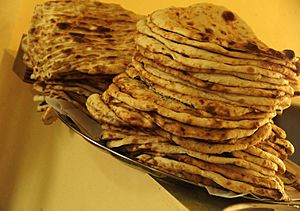
Afghan food uses crops like wheat, corn, barley, and rice. Fruits, vegetables, and dairy products are also common. Kabuli palaw is the national dish. Afghanistan is known for its high-quality pomegranates, grapes, and sweet melons. Tea is a favorite drink. A typical Afghan meal includes bread, yogurt, rice, and meat.
Poetry is a very important part of Afghan culture. Classic Persian and Pashto poetry are cherished. Thursdays are often "poetry night" in Herat. Families gather to read old and new poems. Many famous poets come from Afghanistan, like Rumi and Khushal Khan Khattak.
Holidays and Festivals
Afghanistan's official New Year is called Nowruz. It's an ancient tradition that started as a Zoroastrian celebration. It happens every year in March. Afghans celebrate Nowruz with music, dance, and buzkashi tournaments.
Yaldā is another old tradition. It celebrates the longest night of the year in December. Families gather to read poetry and eat fruits like watermelon and pomegranates.
Religious festivals like Ramadan and Eid al-Fitr are widely celebrated. Afghan Independence Day is on August 19. It marks the country's full independence in 1919.
Sports in Afghanistan
Cricket and football are the most popular sports. The Afghan Sports Federation promotes many sports like basketball, volleyball, and boxing.
Afghan sports teams have won international titles. The basketball team won a title in 2010. The cricket team has also won cups and played in the 2015 Cricket World Cup. The football team won a championship in 2013.
The traditional and national sport is buzkashi. It's like polo, played by horsemen. Two teams try to grab and hold a goat carcass. The Afghan Hound dog breed comes from Afghanistan. It was once used for hunting wolves.
Interesting Facts About Afghanistan
- Afghanistan is officially called the Islamic Emirate of Afghanistan.
- Afghanistan is located in Central and South Asia.
- Afghanistan used to be part of the Persian Empire.
- Afghanistan was on the trade route to China and India. It is near what used to be the Silk Road.
- It made money from lapis lazuli, a beautiful blue gemstone.
- In the 7th Century, Arabs came and made Islam the main religion. Islamic dynasties ruled for centuries.
- Afghanistan has many mountains, including part of the Himalayas.
- Afghanistan has a continental climate with hot summers and cold winters.
- Southern Afghanistan is dry, so there are fewer plants.
- Afghanistan used to have tigers, but they are now gone due to war, hunting, and lack of water.
- The people who live in Afghanistan are called Afghans.
- Dari-Persian and Pashto are the official languages.
- There are few major cities in Afghanistan, but about one-fifth of the total population lives in cities.
Images for kids
-
Tents of Afghan nomads in the northern Badghis province.
-
The extent of the Indus Valley civilization during its mature phase.
-
A "Bactrian gold" Scythian belt from Tillya Tepe.
-
Approximate maximum extent of the Greco-Bactrian kingdom, circa 180 BCE.
-
Saffarid rule at its greatest extent.
-
Map of the Hotak Empire during the Reign of Mirwais Hotak, 1715.
-
Portrait of Ahmad Shah Durrani around 1757.
-
Emir Amanullah invaded British India in 1919 and declared Afghanistan's full independence.
-
King Zahir, the last reigning monarch of Afghanistan (1933-1973).
-
Taliban fighters in Kabul on a captured Humvee following the 2021 fall of Kabul.
-
Köppen climate map of Afghanistan.
See Also
 In Spanish: Afganistán para niños
In Spanish: Afganistán para niños
- Outline of Afghanistan
- History of Afghanistan





